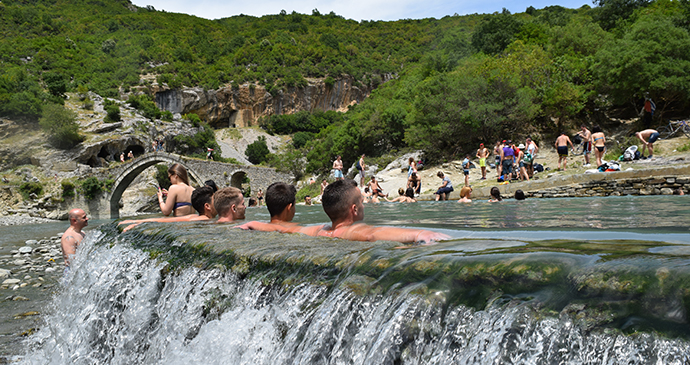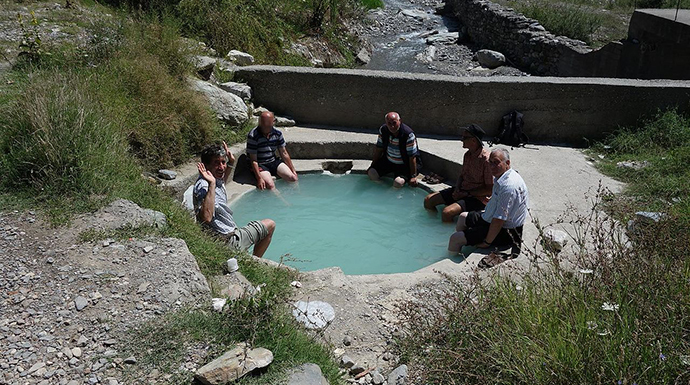Written by Gillian Gloyer
 Enjoy a day out at one of Albania’s many natural thermal waters © Dritan Zaimi, Shutterstock
Enjoy a day out at one of Albania’s many natural thermal waters © Dritan Zaimi, Shutterstock
Albania’s thermal baths have been enjoyed since Roman times. In the 20th century, some of them were developed into spas – they are known generically by the Albanian word Llixhat (the indefinite form is Llixhe). The first to have its waters scientifically tested was Park Nosi, in Llixhat e Elbasanit. The water here was first analysed in 1924, and the spa was built in 1932 by a businessman from Elbasani, Grigor Nosi (a brother of the politician Lef Nosi). Detailed research into the chemical components of the water was conducted by a Czech scientist between 1932 and 1936; the main elements are sodium, magnesium, calcium and potassium. The spa treats a range of ailments, including rheumatism, circulatory problems and skin complaints such as eczema. The water is said also to aid fertility. The springs at Park Nosi rise from 13,000m below the surface and emerge at 56°C; the current administrator remembers, as a child, his grandfather Grigor Nosi boiling an egg for him in the thermal water. Nowadays, many other spa hotels have been built at Llixhat e Elbasanit, although some of them pump their water from underground, rather than allowing it to emerge naturally, as is supposed to be better for the conservation of its medicinal properties.
The current administrator remembers, as a child, his grandfather Grigor Nosi boiling an egg for him in the thermal water.
 There are many public thermal springs in Albania such as this one in Peshkopia © malenki, Wikimedia Commons
There are many public thermal springs in Albania such as this one in Peshkopia © malenki, Wikimedia Commons
Another spa resort, built during the communist period, is near Peshkopia. The water here emerges, from three springs, at just above blood temperature (39–40°C); it comes from the same source, far underground, as Llixhat e Elbasanit and a similar (but much more expensive) spa across the Macedonian border in Kosovrasti. It is so full of sulphur that clients are not allowed to wear jewellery while bathing, because everything except gold will dissolve in it. The original spa here was built in 1964; the current building, with 50 individual bathing cubicles, was one of the last hurrahs of the communist period, inaugurated in 1990. The peak season is September and October, when 3,000 people come through the doors every day. Most people come for a course of treatment of five to seven days, increasing the length of time they soak in the water each day. Hot mud therapy is also available, said to be helpful in the treatment of gynaecological problems and scoliosis. The baths are kept open all year round, for drop-ins by local people or anyone who happens to be visiting Peshkopia. Full courses of treatment are offered from April to October.
The prices at these spas are astonishingly low by northern European standards. A 15-minute soak in a private cubicle costs 100 lek (less than €1). Medically trained staff, often with decades of experience, supervise the spa facilities at all times.
There are free thermal baths, open to the elements, in various places around the Albanian mountains. One of these is at Bënja, near Përmeti, a large open-air pool in a beautiful setting, fed by several thermal springs. Finally, there are numerous drinking-water springs, which are also said to have beneficial medical effects; these are often known as Uji i Ftohtë, the Albanian for ‘cold water’. If you are making long-distance bus journeys in Albania, you will find that buses always stop at these famous spots so that passengers can fill their plastic bottles with this health-giving spring water.
Tempted by Albania’s thermal baths? Here is our new guide:

